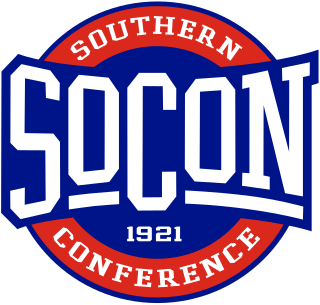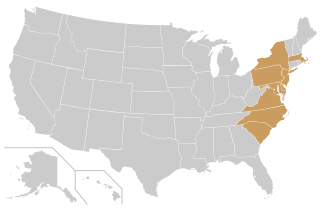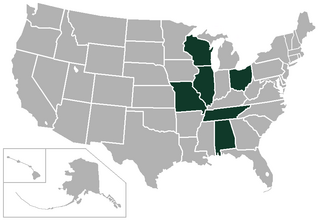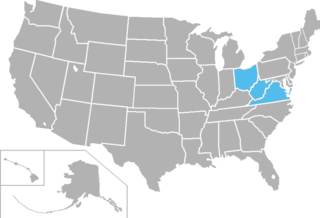
Conference USA (CUSA) is an intercollegiate athletic conference whose member institutions are located within the Southern United States and Western United States. The conference participates in the NCAA's Division I in all sports. CUSA's offices are located in Dallas, Texas.

The Atlantic 10 Conference (A-10) is a collegiate athletic conference whose schools compete in the National Collegiate Athletic Association's (NCAA) Division I. The A-10's member schools are located mostly on the East Coast and Midwest of the United States: Illinois, Massachusetts, Missouri, New York, North Carolina, Ohio, Pennsylvania, Rhode Island, Virginia, and Washington, D.C.

The Southern Conference (SoCon) is a collegiate athletic conference affiliated with the National Collegiate Athletic Association (NCAA) Division I. Southern Conference football teams compete in the Football Championship Subdivision. Member institutions are located in the states of Alabama, Georgia, North Carolina, South Carolina, Tennessee, and Virginia.

The Northeast Conference (NEC) is a collegiate athletic conference whose schools are members of the National Collegiate Athletic Association (NCAA). Teams in the NEC compete in Division I for all sports; football competes in the Division I Football Championship Subdivision (FCS). Participating schools are located principally in the Northeastern United States, from which the conference derives its name.

The South Atlantic Conference (SAC) is a college athletic conference affiliated with the National Collegiate Athletic Association (NCAA) at the Division II level, which operates in the southeastern United States. The SAC was founded in 1975 as a football-only conference and became an all-sports conference beginning with the 1989–90 season.

The Coastal Athletic Association (CAA), formerly the Colonial Athletic Association, is a collegiate athletic conference affiliated with the NCAA's Division I whose full members are located in East Coast states, from Massachusetts to South Carolina. Most of its members are public universities, and the conference is headquartered in Richmond. The CAA was historically a Southern conference until the addition of four schools in the Northeastern United States after the turn of the 21st century, which added geographic balance to the conference.

The Atlantic Sun Conference (ASUN) is a collegiate athletic conference operating mostly in the Southeastern United States. The league participates at the NCAA Division I level, and began sponsoring football at the Division I FCS level in 2022. Originally established as the Trans America Athletic Conference (TAAC) in 1978, it was renamed as the Atlantic Sun Conference in 2001, and briefly rebranded as the ASUN Conference from 2016 to 2023. The conference still uses "ASUN" as an official abbreviation. The conference headquarters are located in Atlanta. On May 8th, 2024, the conference announced it would move its headquarters from Atlanta, Georgia to Jacksonville, Florida in the fall of 2024.

The Great Midwest Conference was an NCAA Division I athletics conference that existed from 1991 to 1995.

Conference Carolinas, formerly known as the Carolinas-Virginia Athletic Conference (CVAC) or the Carolinas Conference, is a college athletic conference affiliated with the National Collegiate Athletic Association (NCAA) primarily at the Division II level. It is also considered as one of the seven Division I conferences for men's volleyball. Originally formed in 1930, the league reached its modern incarnation in 1994. Member institutions are located in the southeastern United States in the states of Georgia, North Carolina, South Carolina, and Tennessee. The Conference Carolinas membership currently consists of 14 small colleges or universities, 12 private and two public.
The Charlotte 49ers are the intercollegiate athletics teams that represent the University of North Carolina at Charlotte in Charlotte, North Carolina. The 49ers compete at the National Collegiate Athletic Association (NCAA) Division I level as a member of the American.

The South Carolina Gamecocks men's soccer team represents the University of South Carolina and, as of the 2022 college soccer season, competes in the Sun Belt Conference. The team is coached by Tony Annan, who succeeded Mark Berson as head coach after the 2020 season. Berson had been the Gamecocks' only head coach since the program's inception in 1978 and had participated in 20 NCAA Tournaments, reaching the Quarterfinals on four occasions. Since 1981, South Carolina has played its home games at Stone Stadium, which is affectionately called "The Graveyard" by South Carolina fans due to an adjoining cemetery.

The NCAA Division I Football Bowl Subdivision (FBS), formerly known as Division I-A, is the highest level of college football in the United States. The FBS consists of the largest schools in the National Collegiate Athletic Association (NCAA). As of the 2024 season, there are 10 conferences and 134 schools in FBS.

The 2005 NCAA conference realignment was initiated by the movement of three Big East Conference teams to the Atlantic Coast Conference, which set events into motion that created a realignment in college football, as 23 teams changed conferences and Army became an independent.

The 2010–2014 NCAA conference realignment was a set of extensive changes in conference membership at all three levels of NCAA competition—Division I, Division II, and Division III—beginning in the 2010–11 academic year.

The Great Midwest Athletic Conference (G-MAC) is a college athletic conference affiliated with the National Collegiate Athletic Association (NCAA) at the Division II level. It was named the 24th NCAA Division II conference and operates in the Great Lakes and East South Central States regions of the United States. The G-MAC began conference play in the 2012–13 academic year hosting 12 championships and continued to work through the educational assessment program. The conference received approval and became an active Division II conference in 2013–14, hosting 17 championships.

The Mountain East Conference (MEC) is a college athletic conference affiliated with the National Collegiate Athletic Association (NCAA) at the Division II level and officially began competition on September 1, 2013. It consists of 11 schools, mostly in West Virginia with other members in Maryland and Ohio.

The American Athletic Conference (AAC), also known as the American, is a collegiate athletic conference in the United States featuring 14 full member universities and eight affiliate member universities that compete in the National Collegiate Athletic Association's (NCAA) Division I, with its football teams competing in the Football Bowl Subdivision (FBS). Member universities represent a range of private and public research universities of various enrollment sizes located primarily in urban metropolitan areas in the Northeastern, Midwestern, and Southern regions of the United States.

The SEC Derby is the set of matches between the University of Kentucky Wildcats and University of South Carolina Gamecocks men's soccer teams. A conference matchup since 2005, since the 2022 season, it has been a conference matchup in the Sun Belt Conference. Both programs had been single-sport members of Conference USA (C-USA) from 2005 through the 2021 season. Both teams are the only colleges in the Southeastern Conference (SEC) which sponsor men's soccer, which the conference does not sponsor as an indirect consequence of Title IX restrictions. South Carolina had started its program in 1978 while an independent, and UK started its program in 1991. From 1991 to 2004, UK had been a Mid-American Conference member for men's soccer only. Despite having joined the Metro Conference in 1983, South Carolina continued to play men's soccer as an independent, not joining for that sport until 1993, two years after the rest of its athletic program had joined the SEC. The Gamecocks also played in the Metro in that league's final men's soccer season of 1994. The following year, C-USA was created with the merger of the Metro with the Great Midwest Conference, a league that had been formed in 1991 by a group of schools that included three charter Metro members. South Carolina was not invited to remain as a men's soccer member after the merger.

Beginning in the 2021–22 academic year, extensive changes occurred in NCAA conference membership, primarily at the Division I level.

















